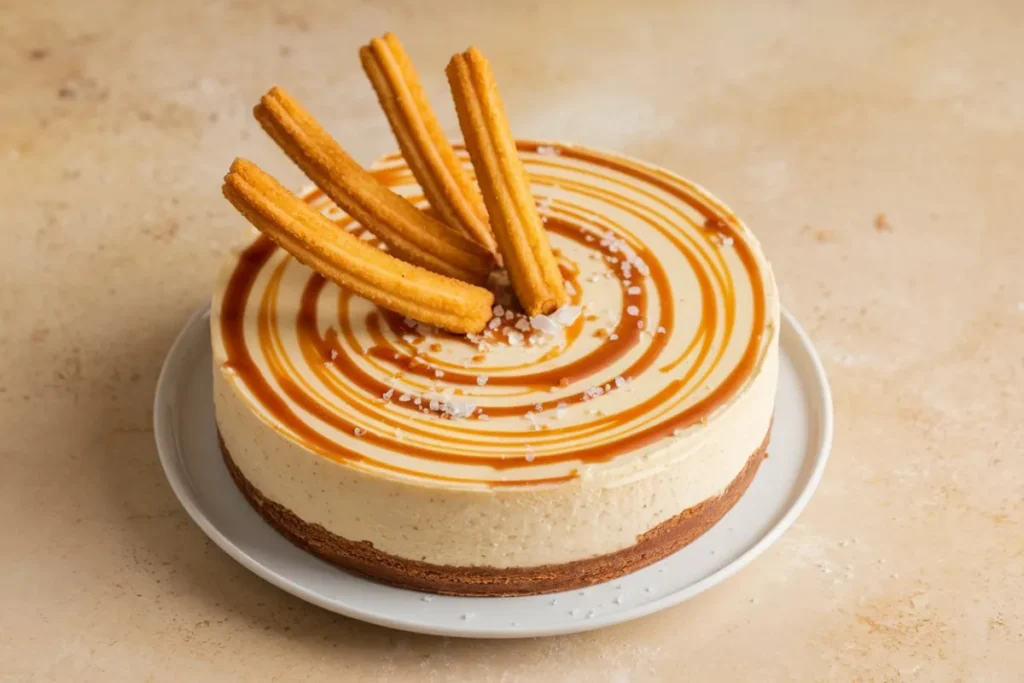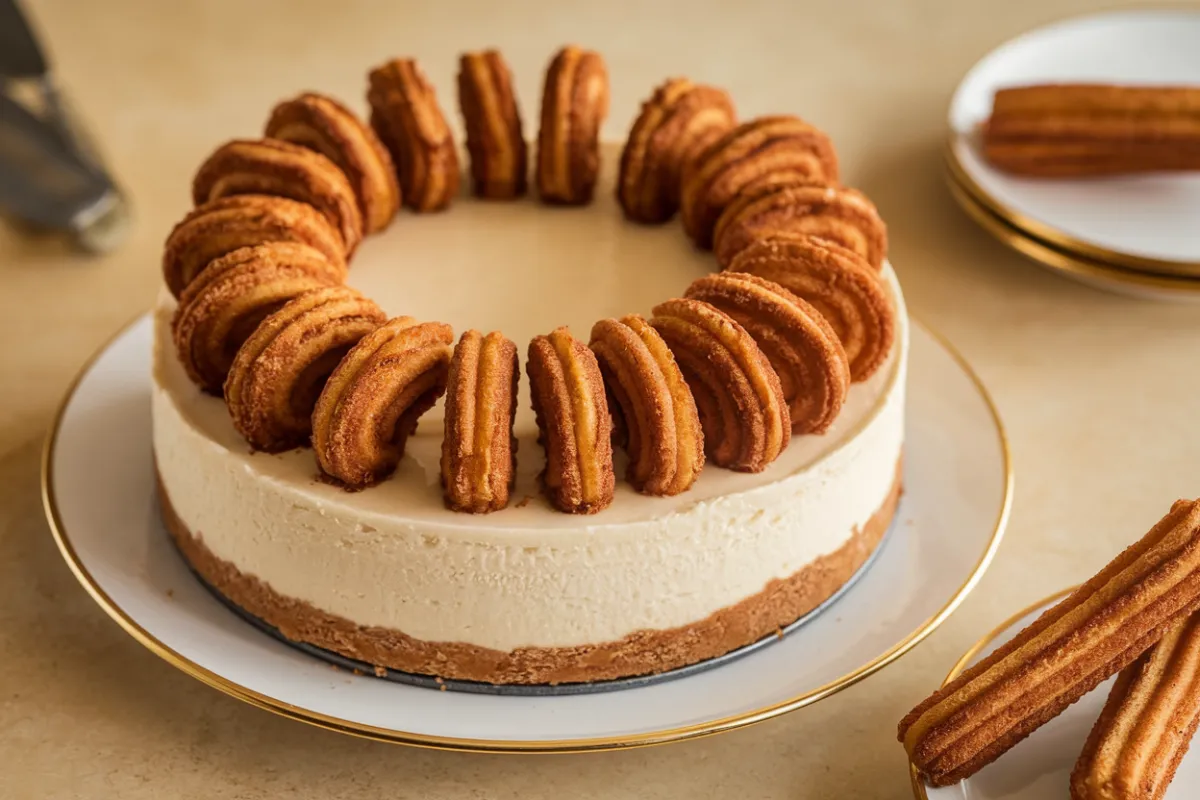Introduction
Cheesecake is a dessert that appeals to many due to its rich flavor, creamy texture, and adaptability to different occasions. A popular variation is the churro cheesecake, which combines the sweet tanginess of a cheesecake with the warm, crispy cinnamon-sugar coating of a churro. However, the question of whether you can leave churro cheesecake out overnight is essential, especially for health and safety. This article explores the implications, provides food safety guidelines, and offers best practices to ensure your cheesecake stays safe and delicious.
What is Churro Cheesecake?
Churro cheesecake merges two beloved desserts: the classic cheesecake and the churro. This dessert typically includes a creamy cheesecake filling made from cream cheese, eggs, sugar, and vanilla, layered between dough or pastry that is coated in cinnamon sugar. The result is a dessert with a delightful mix of textures—a crunchy exterior and a smooth, rich interior.
However, churro cheesecake contains several perishable ingredients, such as dairy products like cream cheese and eggs. These ingredients spoil quickly if left out at room temperature for too long. The USDA Food Safety Guidelines state that dairy-based desserts should not remain at room temperature for more than two hours. Ignoring these guidelines increases the risk of foodborne illnesses.
Why Does Cheesecake Need Refrigeration?
Cheesecakes, including churro cheesecake, require refrigeration due to their perishable ingredients. These ingredients include:
- Cream Cheese: This soft cheese contains moisture and fat, providing a perfect environment for bacteria like Salmonella and Listeria to grow.
- Eggs: Eggs add richness and structure to the cheesecake, but they can also carry bacteria if not stored correctly.
- Dairy Products: Ingredients like sour cream or heavy cream can spoil quickly without proper refrigeration.
According to the Dairy Council Food Safety Tips, dairy products should always stay below 40°F (4°C). When you leave cheesecake out overnight, bacteria such as Staphylococcus aureus can grow rapidly and produce toxins that heating cannot destroy.
How Bacteria Grows in Cheesecake
Bacteria multiply fastest in the “danger zone”—between 40°F and 140°F (4°C to 60°C). Within this range, bacteria can double in just 20 minutes. Since cheesecakes are moist, nutrient-rich, and contain dairy, they provide an ideal environment for these microorganisms.
The most concerning bacteria in cheesecake are:
- Listeria monocytogenes: Common in soft cheeses, it can cause severe illness, particularly in pregnant women, older adults, and those with weakened immune systems.
- Salmonella: Often found in raw eggs, it can cause symptoms like diarrhea, fever, and stomach cramps.
- Staphylococcus aureus: This bacteria can produce toxins in foods left at the wrong temperatures, leading to rapid foodborne illness.
Risks of Leaving Churro Cheesecake Out Overnight
When you leave churro cheesecake out overnight, several risks arise:
- Bacterial Growth: Warm or humid conditions allow bacteria like Salmonella, Listeria, and Staphylococcus aureus to multiply quickly. Cheesecake left out overnight could harbor millions of bacteria.
- Mold Formation: Mold spores in the environment can settle on a cheesecake left out, leading to visible mold over time.
- Food Poisoning: Consuming cheesecake left out overnight can cause food poisoning symptoms, such as nausea, vomiting, diarrhea, and stomach cramps. In severe cases, it may require hospitalization.
- Hidden Spoilage: Cheesecake may not always show obvious signs of spoilage, such as off smells or discoloration, even when bacteria are present. This makes it harder to know if it is safe to eat.
Key Food Safety Guidelines for Cheesecake
To keep your churro cheesecake safe, follow these essential food safety guidelines:
- Refrigerate Promptly: Store cheesecake in the refrigerator within two hours of preparation or serving. If the temperature is above 90°F (32°C), reduce this time to one hour.
- Maintain Proper Temperature: Keep your refrigerator at or below 40°F (4°C). Lower temperatures slow bacterial growth, reducing the risk of spoilage.
- Use Airtight Containers: Store cheesecake in airtight containers or wrap it tightly in plastic wrap or aluminum foil to prevent air and moisture exposure, which can cause spoilage.
- Label and Date: Label the container with the date to keep track of how long it has been stored. Consume refrigerated cheesecake within 3-4 days.
Factors That Affect Cheesecake Safety When Left Out
Many factors can affect whether your churro cheesecake is still safe to eat after being left out:
- Temperature of the Room: Warmer temperatures speed up bacterial growth, while cooler temperatures slow it down. If you leave cheesecake in a warm room or during the summer, it will spoil faster.
- Humidity Levels: High humidity promotes mold growth and increases the risk of bacterial contamination.
- Packaging: Cheesecake left uncovered is more exposed to airborne contaminants and moisture loss, making it more likely to spoil.
- Duration: The longer you leave the cheesecake out, the higher the risk of bacterial growth and spoilage.
Is It Safe to Salvage Cheesecake Left Out Overnight?
If you discover your churro cheesecake was left out overnight, you might wonder if you can still save it. The answer depends on several factors, but it’s generally best to discard any cheesecake left out for more than two hours. Here’s what to consider:
- Check for Spoilage Signs: Look for mold, discoloration, or a sour smell. These are clear signs that the cheesecake is unsafe to eat.
- Consider the Temperature: If you left the cheesecake in a cool place (below 70°F or 21°C), the risk may be lower, but this does not guarantee it is safe.
- Evaluate the Time: Cheesecake left out for less than four hours may have a lower risk, but it is still not recommended to eat.
- Understand the Risks: Even without visible signs of spoilage, eating cheesecake left out overnight carries a risk.
Best Practices for Storing Churro Cheesecake

To keep your churro cheesecake fresh and safe, follow these best practices:
Short-Term Storage Tips
- Refrigerate Immediately: Place the cheesecake in the refrigerator as soon as possible. Use airtight containers or wrap tightly in plastic wrap or aluminum foil.
- Avoid Temperature Changes: Store the cheesecake in the coldest part of the refrigerator, away from the door, to avoid temperature changes that can lead to spoilage.
Long-Term Storage Tips
- Freeze for Extended Storage: If you need to store the cheesecake for more than 3-4 days, freeze it. Wrap the cheesecake tightly in plastic wrap, cover it with aluminum foil, or place it in a freezer-safe bag or container. Frozen cheesecake keeps well for up to 2-3 months.
- Thaw Safely: When ready to eat, thaw the cheesecake in the refrigerator overnight. Do not thaw at room temperature, as this encourages bacterial growth.
Proper Packaging Materials
- Use Plastic Wrap and Aluminum Foil: These materials help minimize exposure to air and moisture.
- Select Airtight Containers: Airtight containers prevent contamination and help retain moisture.
Alternatives to Leaving Cheesecake Out
If you cannot refrigerate your cheesecake immediately, consider these alternatives:
- Use a Cooler: Store the cheesecake in a cooler with ice packs to maintain a low temperature, especially during transport.
- Insulated Bags: An insulated bag can keep the cheesecake cool for short periods, such as when traveling.
- Mini Fridges: A mini fridge or portable cooler can be useful if you frequently serve cheesecake at events.
Extended FAQs About Cheesecake Safety
Q: How long can churro cheesecake sit out?
A: You should not leave churro cheesecake out for more than two hours at room temperature. If it’s above 90°F (32°C), limit this time to one hour.
Q: What are the signs of spoiled cheesecake?
A: Look for signs such as discoloration, visible mold, a sour smell, and changes in texture. These indicate that the cheesecake is unsafe to eat.
Q: Is it safe to eat cheesecake left out for 5-6 hours?
A: Cheesecake left out for this long is risky. Bacteria multiply quickly at room temperature, so it is safer to refrigerate or discard it after two hours.
Q: Can reheating make a left-out cheesecake safe?
A: Reheating may kill some bacteria but cannot remove toxins that might have formed. Reheating is not a reliable method for making cheesecake safe.
Q: How should I store cheesecake to prevent spoilage?
A: Refrigerate the cheesecake immediately, keep it covered in an airtight container, and consume it within the recommended time frames.
Q: Can I freeze churro cheesecake to extend its shelf life?
A: Yes, freezing extends the shelf life of churro cheesecake. Wrap it tightly in plastic wrap and aluminum foil, or use a freezer-safe bag or container. It can remain frozen for up to 2-3 months. Thaw it in the refrigerator before serving.
Q: How do I know if my cheesecake is safe to eat after freezing?
A: When thawing cheesecake, check for any changes in texture, color, or smell. If it appears normal and smells fresh, it is likely safe to eat. Discard it if there are signs of spoilage.
Q: What is the best way to transport cheesecake without refrigeration?
A: Use an insulated bag or cooler with ice packs to keep the cheesecake at a safe temperature during transport.
Q: Are there any preservatives that make cheesecake safer to leave out?
A: Some commercial cheesecakes contain preservatives to extend shelf life, but these are not foolproof. Always refrigerate homemade cheesecake promptly.
Conclusion
To enjoy your churro cheesecake safely, follow the proper storage guidelines. Leaving a churro cheesecake out overnight can lead to bacterial growth, mold, and foodborne illness. To avoid these risks, refrigerate it promptly, use proper packaging, and consume it within the recommended time frame. With these precautions, you can enjoy every delicious bite without worry.
Additional Tips and Resources
Consult reliable resources to further ensure your cheesecake’s safety:
- USDA Food Safety Guidelines for more advice on storing dairy products correctly.
- Healthline Reheating Tips for safe reheating practices and minimizing the risk of foodborne illnesses.
Expert Opinions and Best Practices
Food safety experts emphasize the importance of refrigerating dairy-based desserts like churro cheesecake promptly. The USDA states, “Once dairy products have been left out at room temperature for two hours or more, they must be discarded.” This advice aligns with other food safety authorities.
Tips for Cheesecake Lovers
Here are some additional tips for those who enjoy making or serving churro cheesecake:
- Plan Ahead: Make sure your refrigerator has enough space for the cheesecake, especially if you plan to serve it at an event.
- Label Clearly: When storing cheesecake, label it with the date it was prepared or purchased. This helps you keep track of its freshness.
- Portion Wisely: Slice the cheesecake into smaller portions before refrigerating or freezing. This approach makes storage easier and reduces waste.
Final Thoughts
Keeping your churro cheesecake safe comes down to proper storage and understanding the risks associated with leaving it out at room temperature. Always refrigerate promptly, use the right packaging, and consume it within safe time frames. By taking these steps, you can enjoy your cheesecake worry-free, knowing it is both delicious and safe.

